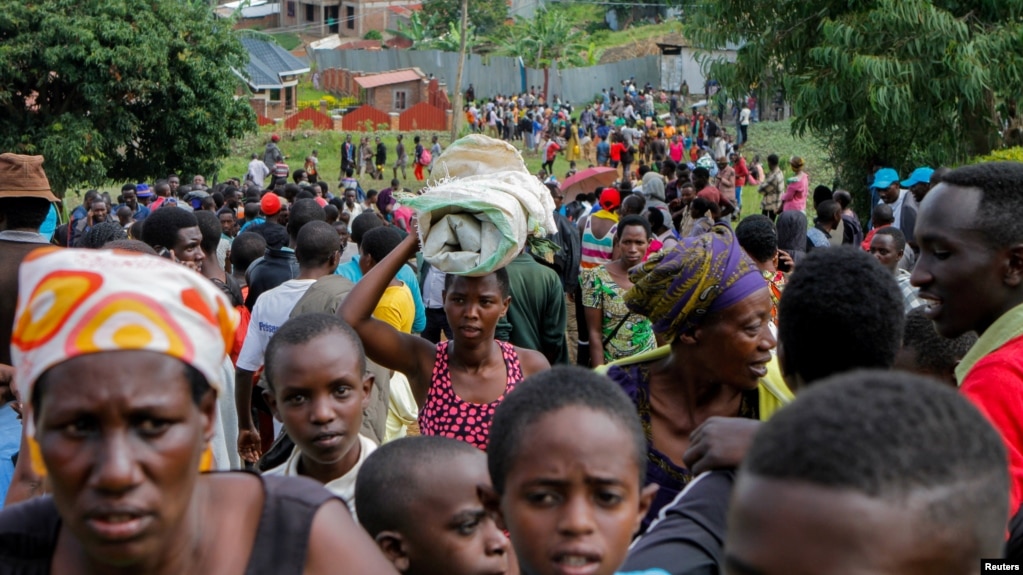A military officer disperses supporters of opposition leader Kizza Besigye who had gathered to welcome him back to Kampala from Nairobi where he was seeking medical attention on May 12.
By Julius Barigaba, Special Correspondent
Posted Sunday, May 29 2011 at 14:26
Posted Sunday, May 29 2011 at 14:26
With armoured vehicles popularly known as Mamba sealing off the Constitution Square in the middle of the capital, the possibility of it creating a Ugandan version of Tahrir Square looks remote.
Tear gas and water canons have been parked around it for several months now, with policemen keeping vigil. But that might be a good thing. For all its resonance with Africa — and much of the Arab world — the Egyptian Tahrir is an aberration that is not going to happen every day, everywhere — least of all, in Uganda.
Security is blocking access to Constitution Square, not to prevent a Tahrir, but to foil something worse — an Armageddon. Think Beijing’s Tiananmen Square, 1989.
Tahrir collected a million anti-Mubarak protestors over three weeks, leading to the dictator’s fall in February this year. In Beijing, however, Tiananmen was the scene of a massacre by a military whose mindset is that of anarchy, akin to that of Uganda’s armed forces, according to political analyst Mwambutsya Ndebesa, professor of history at Makerere University.
Led by students and intellectuals, the Tiananmen uprising, started on April 15, 1989. In four weeks, then Chinese premier Li Peng had declared martial law. On June 4, tanks and troops descended on the Square and slaughtered the protestors in their thousands.
In Egypt, it was a pro-people army that could not shoot at the protestors. The same cannot be said of Uganda’s armed forces, going by number of casualties in one month of protests — so far nine shot dead, and some of them were not even rioting.
Constitution Square touches the busy Kampala Road at the bottom, the High Court Building on the opposite side, hugging both the East African Development Bank building and Central Police Station on either side.
Further down is Kampala’s busiest section of the CBD: Trade activity, matatus, human traffic, mobile salesmen, vendors perched on shop fronts, pickpockets, are all here. It is frightening to imagine what would happen if security were to let protestors into Constitution Square and open fire.
The Square has become a no-go area, barricaded by blue Mamba APCs, tear gas trucks and anti-riot police. To dare to go there is to court arrest, unlimited doses of teargas, gunshot wounds, and possibly, death.
On May 10, former presidential candidates Norbert Mao, Olara Otunnu, Sam Lubega and Mohammad Kibirige Mayanja attempted to access Constitution Square and stage a rally there. Somewhat Mao and Mayanja sneaked through the first line of police cordon but could not go past the next.
“We want to hold a rally in the Square that is named after our (1995) Constitution. It is our right,” Mao yelled at the police as they pushed him back.
But Otunnu, Lubega and others were not lucky. A police truck spewing pink liquid pushed them 200 metres away, bathing them in a deluge of crimson — police’s latest anti-riot innovation.
That is the norm in Kampala these days — people wake up to a menu of live bullets and teargas. Access to some roads is blocked, as boda boda cyclists, unemployed youths and Kisekka Market traders engage the military and police in running battles. Occasionally, a military chopper eerily monitors the action. Files of military men, with guns held combat style, patrol the streets; APCs are at entry points into the city.
How long before tanks come out?
Police spokeswoman Judith Nabakoba denies that deployment of military, police and heavy weaponry at Constitution Square and other strategic points in the city is not to crush opposition protests.
“We have terrorism threats. This (deployment) should not be looked at as targeting only protestors and the opposition,” she told The EastAfrican.
Fair enough, indeed Uganda is a terrorist target — the ghastly images of 7/11 twin bombings in Kampala still torment the survivors.
Nonetheless, the manner of deployment still raises questions. The mambas and troops, for instance, are not only stationed at Constitution Square, Uganda’s equivalent of Tahrir, but they are a permanent feature at the Kibuye roundabout and several points along Entebbe Road, and Kalerwe roundabout on Gayaza Road.
These roads lead to opposition leader Kizza Besigye’s work place and home respectively. Besigye is the face of resistance in the ongoing showdown between government and opposition.
Besides this, in Masaka, Mukono, Luwero, Jinja, Mbale, Gulu and a few other towns in the north, the presence of the military is equally pronounced. These towns hold the highest concentration of anti-government sentiment. Towns in western Uganda — the stronghold of the ruling party — have no such deployment.
Since the February 18 elections, opposition leaders have questioned the legitimacy of president Museveni’s 68 per cent win. They claim this “victory” is courtesy of two things: Money to buy votes, and an arsenal brought out onto the streets to intimidate voters.
After arresting Besigye on April 11, police chief Kale Kayihura fluffed his lines big time but gave pointers why Constitution Square is restricted. He told journalists that the non-violent protests must be crushed. Yet he confessed that the police arrested the walking politicians but “quite frankly we did not know where they were going... along the way they wanted to find masses...they thought they would create a Tahrir Square somewhere in the city centre.”
Thus Constitution Square is no longer ‘the people’s space’ where they can go to drown the misery of today’s economic hardships or to escape the depression caused by it.
But lately, the Square gives a disconcerting sense of Tiananmen. You would think Kampala was a combat zone, or that the president has declared martial law.
It’s a siege that will hurt Uganda’s economy, political sanity and rule of law, argues FDC Secretary for Security Major John Kazoora.
“That’s what they want. Let’s remain a police, besieged state,” he said. “Let our children grow up in a culture of being surrounded by guns and mambas because that’s the culture we have built. In the end we are hurting ourselves and scaring away tourists and investors. Is that what we want for our country?
Asked whether the uprising will climax in a mass demo at Constitution Square as claimed by security, he replies, “I am a founder member of A4C (Activists for Change); our campaign is about high prices, not to go to Constitution Square; why do they put words in our mouth?”
Tour operators warned recently that Uganda will lose $100 million worth of tourism revenue monthly if the riots persist. But it is not tourists alone that are put off by the military hardware on display. In five months, Kampalans have seen more mambas than they have ever cared to.
“I am from the north but I had never seen so many mambas before,” says legislator Odonga Otto.
“I am from the north but I had never seen so many mambas before,” says legislator Odonga Otto.
As the theatre of war for two decades, Northern Uganda endured this. Now the south, which enjoyed uninterrupted stability all this time, is being treated to real images of war, without actually being in one. It is the perfect irony of a country that is at peace.
The see-saw events between opposition and government in the post February 18 election period pose some serious questions. Why does a man who was given such a bad beating at the polls attract so many crowds, some ready to die for him? What would happen if government let him get to Constitution Square? He scored only 26 per cent, after all. So, he would attract only a few thousand.
Not really. Besigye has built a magnetism that his tormentors cannot undo.
The events of Thursday May 12, sum up as the spectacular climax of the tensions that had built up since the Walk-to-Work campaign started a month earlier to protest soaring fuel, food and commodity prices.
It culminated into a clash of two forces — Besigye’s ‘army’ of boda boda cyclists and unemployed youth, armed with only twigs and their v-signs, overwhelming state police and military. Yes, some rode their motorcycles acrobatically enough to kill themselves, but they generally went about it peacefully, and the police were ready to take this humbling lesson, but not the military.
“From the airport to Katabi, the crowds were non-violent because [Assistant Inspector General of Police, Francis] Rwego was in charge. Then the military took over and Rwego was annoyed because unprovoked, the military started beating and tear gassing people,” Maj Kazoora says.
For his troubles, Rwego was suspended on May 17 and his sin is to have allowed a snail pace convoy. In the end, a 45-minute drive took nine hours with Besigye’s supporters and Museveni’s swearing-in entourage scrambling for space on the small Entebbe road.
Initially, the agreement was to allow three vehicles with police lead and escort cars in his convoy. But the numbers kept swelling, and police chose to accommodate them, provided that the crowds remained non-violent.
Diplomatic embarrassment
Police and military descending on the crowds with live bullets, tear gas and chemicals was the ultimate diplomatic embarrassment, particularly when Besigye’s crowd responded by throwing stones at motorcades of presidents that attended Museveni’s inauguration.
Angered by this episode, Museveni’s military might react in radical style. It is the best way to deal with an unrelenting opposition that has braved violence, but built up some momentum to resist since April 11. This might trigger a Tiananmen-like response.
The increased presence of military hardware in the middle of the capital is twofold: To drive fear, and it is also a statement of intent, political actors argue.
“We know the NRM intends to unleash the army in civilian clothes. This is a ploy that is so transparent we can see through it. We want to demystify the fear Museveni has instilled in the public; thereafter this campaign will evolve into a social movement,” says Otunnu.
Yet there is more to come. In the next financial year, police has just put in a budget request for Ush29 billion ($12.4 million) for tear gas and anti-riot gear alone. And they need new supplies too, because some of the current stock of tear gas being used actually expired in 2004.
So, will opposition foot soldiers cower from the mambas and tanks? Apparently not. Those that have not been shot dead (Human Rights Watch recently documented nine people, but that was before five other deaths reported in the May 12 fiasco), have been tear gassed and beaten, but they have marched on, buoyed by Besigye’s famous “you should not be intimidated” line.
In a recent interview with the Monitor, IGP Kayihura stated that a police officer who escorted protestors to their place of work was ‘guilty’ while the one who used the butt of his gun to vandalise Besigye’s car, was hailed as ‘doing his job’.
In short, when the order to unleash violence comes, the executing man will not waver. In the meantime, politicians and protestors can get close to Constitution Square if they are looking for a repeat of Tiananmen.












